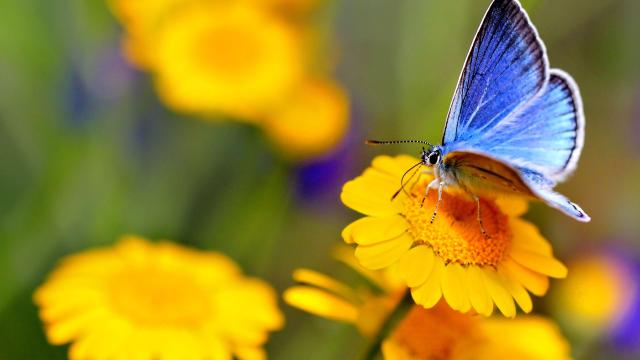I don’t care how cynical you are, you will be delighted at the sight of butterflies in your garden or backyard. Not only are these colourful insects beautiful, they pollinate plants, attract birds, inspire Mariah Carey, and provide us with an overused metaphor for transformation.
To draw butterflies to your yard, you have to ask yourself what butterflies want. Ask yourself, “Why would a butterfly want to hang around my yard instead of my neighbour’s?” The simple answer: Butterflies are looking for a mellow place to raise butterfly families. They want a quiet spot to lay eggs, with food-plants for their larvae, branches for their chrysalides to hang on, nectar sources, places to hide, and somewhere to relax.
For flowers that attract butterflies, think “stay local”
Butterflies and flowers go together like Starsky and Hutch. They drink nectar from a ton of different kinds of flowers, but not every bloom is equal. To increase your garden’s chance of butterfly abundance, native flower species are your best bet. The local butterflies and local flowers evolved together, after all. Check out the Lady Bird Johnson Wildflower Center site for a state-by-state flower guide to give you ideas for what to plant.
According to The National Wildlife Federation, adult butterflies are most attracted to the sweet nectar from “red, yellow, orange, pink and purple blossoms that are flat-topped or clustered and have short flower tubes.” For more specific information, check out this excellent butterfly nectar plant list.
Where you plant your blooms is important, too. Butterflies generally only feed in the sun (which is adorable), so for optimum butterfly attraction, make sure your flowers receive lots of light from mid-morning to mid-afternoon.
Research where they’ll want to lay their eggs
Butterflies may drink nectar from a ton of different flowers, but they are way more picky about where they lay their eggs. Monarch butterflies, for instances, only lay eggs on milkweed, where black swallowtails only lay eggs on rue plants. There are about 750 species of butterflies in the United States, so your best bet it is to do a little research on your local ‘flies. Find out where they want to lay eggs and plant that. Many states have official butterflies. This list is a good place to start.
Also, remember: You can’t have butterflies without caterpillars. A garden full of the plants that local caterpillars eat is the best bet, but each kind of caterpillar feeds on only a small variety of plants. There are 180,000 species of caterpillars, give or take, so you’ll have to do the research on what kinds live around you.
Think about their safety — and how they’ll spend their downtime
Your new butterfly friends will need a place to hide from predators. While there are butterfly habitats you can buy, they will probably be more likely to spend time in natural spaces like hollow logs, tree branches, or stacked up firewood. They love small nooks and little hidey-holes to escape the birds, lizards, and snakes that would eat them.
Life isn’t all nectar-drinking and transforming from one form to another; in their downtime, butterflies like to sunbathe and splash around in shallow puddles. (Butterflies are so damn cute.)
Set up flat rocks in a sunny part of your yard so they can dry their wings and sunbathe. Some butterfly enthusiasts report that they haven’t had much luck with basking stones, but it can’t hurt.
Butterflies also like “puddling,” mucking about in wet sand or mud where they can take drinks and extract minerals from the water. Sink some pans filled with a little water and coarse sand in the soil to give them a watering hole. Keep the sand moist but don’t add too much water. You’re not making a lake, you’re making a mud puddle.
Feed them rotten fruit
Some kinds of butterflies (the red spotted purple, question mark, mourning cloak, green comma, malachite, red admiral, hackberry and tawny emperors, and the viceroy, according to joyfulbutterfly.com) like getting nectar from rotten fruit. You may have noticed butterflies hanging around your compost for this reason. If you want to attract these kind of butterflies, you can put some overripe peaches in a plant hanger and hang it from a branch, or just put it on a plate on your deck railing. Just be aware that this will likely attract wasps, ants, flies, and other pests, too, though.
Lay off the poison
If you want butterflies, you’re going to have to lay off insecticides. These poisons can’t tell the difference between pests and butterflies.

Leave a Reply
You must be logged in to post a comment.